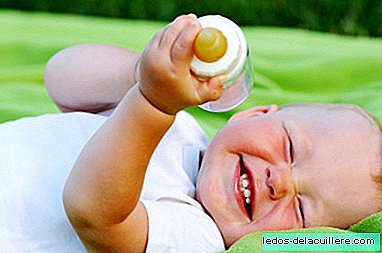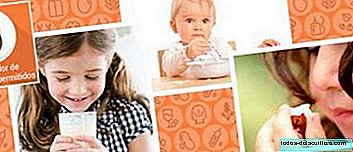
Breast milk is the ideal food for the young infant, either exclusively during the first 6 months or as a majority food during the second half of life. However, after 12 months, you may ask yourself what is the most appropriate type of milk, since at this age, although breastfeeding is still possible and recommended, it is limited in most cases.
In the market there are numerous growth milks to drink from the year, whose composition is most heterogeneous because its formula is not regulated specifically. Next we help you to choose the best one for your baby teaching you what components you should look for in its labeling, and what is its effectiveness to meet the nutritional needs of this stage compared to cow's milk.
Why is it important to look at the label?
The composition of continuation milks has specific national and European legislation, but this is not the case for growth milks. As a consequence, the composition of these in Spain is very varied.
In some cases it resembles that of the continuation formulas, but in others it is more similar to that of cow's milk, which would be a poor protein contribution for a child of this age.
For this reason it is very important look at your labeling to find the most suitable for our baby, paying special attention in that they do not have added sugar and only contain the natural sugar of milk (lactose). As the current regulation on labeling prevents differentiating between both types of sugar (it appears under the heading "Carbohydrates / of which sugars", it is advisable to look for the legend "without added sugar" to be sure that we make the right choice.

An adequate growth milk should have a lower amount of protein than cow's milk, and be supplemented with the necessary nutrients for this period of life.
The ideal composition of a growing milk
To meet the specific needs of this age, a good growth milk must have a reduced protein content and a modified lipid profile and more balanced. Therefore, it has to incorporate more polyunsaturated fatty acids (such as Omega 3 DHA) and monounsaturated fatty acids, and reduce the saturated fat content.
In addition, a good growth milk should contain minerals and vitamins in adequate amounts and must not have added sugar. With this in mind, when looking at your label, we must look at the following values:
Carbohydrates. Cow's milk provides about 4-5 g of lactose per 100 ml of milk. Growing milk, in addition to lactose, often contains added sugars such as sucrose, honey or fructose, which should also be included in the list of ingredients.
Fat. The average growing milk has about 3g of total fat per 100 ml. It is a content quite similar to that of cow's milk, but in this case part of the saturated fat must be replaced by vegetable fat or fish oil. This increases the content of unsaturated and essential fatty acids, such as omega-3 DHA, which are beneficial for the child's growth and mental development.

Protein. Its figure should preferably be lower than that of cow's milk, which usually has a little more than 3g per 100 ml. to lower the protein load. An excess of protein in the diet of young children has been linked to an increased risk of obesity in adulthood.
Vitamins. These milks are usually enriched with vitamins and the presence of vitamin D (which in cow's milk is scarce and does not cover the child's needs) is especially relevant, since it is vital for calcium absorption and, therefore, for bone development.
Minerals. This section highlights the presence of iron that must be shown in proportions higher than those presented in cow's milk (more than 1mg per 100ml), which is deficient in this aspect.
It is also possible to expect the presence of other components that allow the growth of milk to resemble breast milk and also cover nutrient recommendations for ages between 1 and 3 years. For example: probiotics (living organisms) and prebiotics (fructoligosaccharides) in order to improve the intestinal flora.
Is growth milk effective?
A balanced diet would be enough to meet the nutritional needs of children. However, in our environment it is common that some excess nutrients (such as proteins) are consumed and insufficient amounts of others are ingested.
The ALSALMA study is the first Spanish study on dietary intake in children aged 0 to 36 months carried out by 200 pediatricians across the country with a representative sample of almost 2,000 children. This study revealed an excessive consumption of proteins and a low consumption of AGP, vitamin D, iron and folic acid, especially in children under one year of age.
The results of the study highlight the risk of child overweight and the deficit in the intake of essential nutrients due to the imbalance of the diet and other factors such as food tastes in the process of defining the child, the lifestyle of families, etc.
In this context, the type of milk that young children should consume is worth mentioning, as it is a staple in their diet. Cow's milk provides 32% of the proteins in children aged 13-24 months, and 28% in children aged 25-36 months. That is to say: unmodified cow's milk contributes, to a large extent, to the high protein contributions found in their diet (approximately 18% of the VCT).

On the other hand, it has a low amount of other essential nutrients such as vitamin D or iron. Therefore, if consumed in high quantities, it can contribute to an inadequate intake of nutrients and an iron deficiency.
For these reasons, especially in children with unbalanced diets or with special nutritional needs, it is more appropriate to continue with a formula milk until 2-3 years of age. The following are dairy formulas intended for infants aged 6-12 months. To help alleviate some of the nutritional deficiencies of 12 to 36 months, growth is the only specially formulated milk.
Changing the classic milk glass for one of growing milk is a small gesture That can make a big difference with clear nutritional impact on the child's diet.
Images | iStock / Grase / CroMary / Shalamov.












